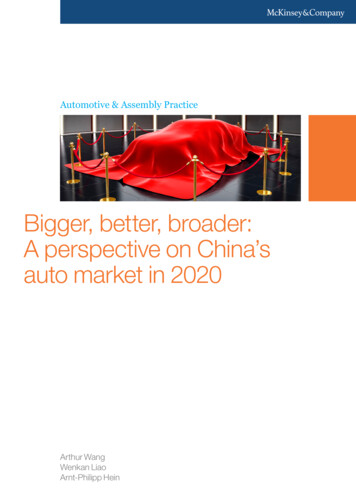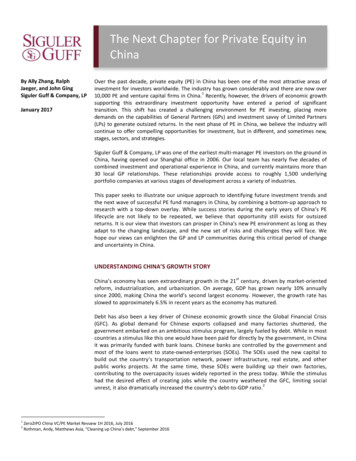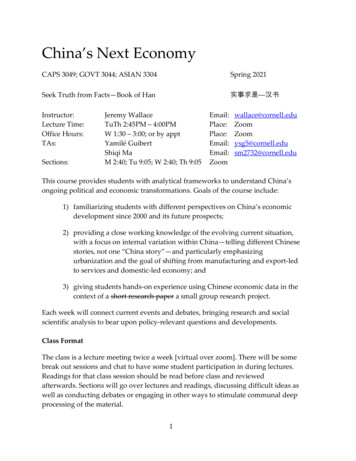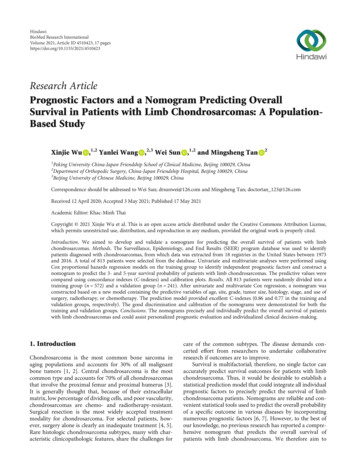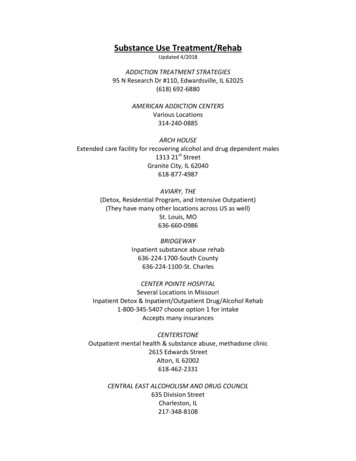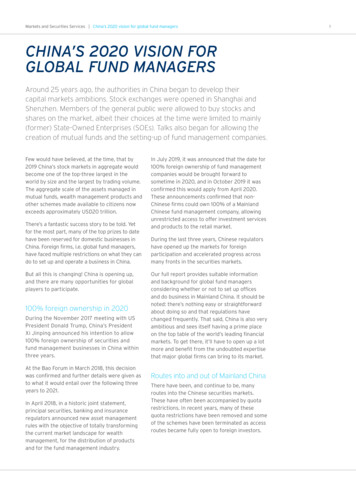
Transcription
Markets and Securities Services China’s 2020 vision for global fund managersCHINA’S 2020 VISION FORGLOBAL FUND MANAGERSAround 25 years ago, the authorities in China began to develop theircapital markets ambitions. Stock exchanges were opened in Shanghai andShenzhen. Members of the general public were allowed to buy stocks andshares on the market, albeit their choices at the time were limited to mainly(former) State-Owned Enterprises (SOEs). Talks also began for allowing thecreation of mutual funds and the setting-up of fund management companies.Few would have believed, at the time, that by2019 China’s stock markets in aggregate wouldbecome one of the top-three largest in theworld by size and the largest by trading volume.The aggregate scale of the assets managed inmutual funds, wealth management products andother schemes made available to citizens nowexceeds approximately USD20 trillion.There’s a fantastic success story to be told. Yetfor the most part, many of the top prizes to datehave been reserved for domestic businesses inChina. Foreign firms, i.e. global fund managers,have faced multiple restrictions on what they cando to set up and operate a business in China.But all this is changing! China is opening up,and there are many opportunities for globalplayers to participate.100% foreign ownership in 2020During the November 2017 meeting with USPresident Donald Trump, China’s PresidentXi Jinping announced his intention to allow100% foreign ownership of securities andfund management businesses in China withinthree years.At the Bao Forum in March 2018, this decisionwas confirmed and further details were given asto what it would entail over the following threeyears to 2021.In April 2018, in a historic joint statement,principal securities, banking and insuranceregulators announced new asset managementrules with the objective of totally transformingthe current market landscape for wealthmanagement, for the distribution of productsand for the fund management industry.In July 2019, it was announced that the date for100% foreign ownership of fund managementcompanies would be brought forward tosometime in 2020, and in October 2019 it wasconfirmed this would apply from April 2020.These announcements confirmed that nonChinese firms could own 100% of a MainlandChinese fund management company, allowingunrestricted access to offer investment servicesand products to the retail market.During the last three years, Chinese regulatorshave opened up the markets for foreignparticipation and accelerated progress acrossmany fronts in the securities markets.Our full report provides suitable informationand background for global fund managersconsidering whether or not to set up officesand do business in Mainland China. It should benoted: there’s nothing easy or straightforwardabout doing so and that regulations havechanged frequently. That said, China is also veryambitious and sees itself having a prime placeon the top table of the world’s leading financialmarkets. To get there, it’ll have to open up a lotmore and benefit from the undoubted expertisethat major global firms can bring to its market.Routes into and out of Mainland ChinaThere have been, and continue to be, manyroutes into the Chinese securities markets.These have often been accompanied by quotarestrictions. In recent years, many of thesequota restrictions have been removed and someof the schemes have been terminated as accessroutes became fully open to foreign investors.1
Markets and Securities Services China’s 2020 vision for global fund managers2China’s 2020 vision for global fund managers: key driversChanges are taking place that will transform fund management: Regulatory changes in 2019 promise to accelerate the opening-up of fund management for domestic life insuranceand pensions businesses, for banks and for foreign fund managers. From April 2020, foreign fund managers will be allowed to own 100% of domestic retail fund management companies.The People’s Republic of China (Mainland China, China)*The world’s most populous country: 1.4bn (2017).16 cities with a population of more than 4m.The third-largest country by size: 9.6m sq km.3 cities with a population of more than 10m.22 provinces, 5 autonomous regions,4 directly controlled municipalities,2 special administrative regions.338 billionaires and 3.5m millionaires (2018).The second-largest global economy(by nominal GDP).Regulated funds of over USD2tn (Q3 2019).Unregulated wealth management productsissued by banks of over USD6tn.The second-largest equity and bond marketsglobally (by turnover and size).A private and trust funds market of overUSD6tn.50 cities with a population of more than 1.5m.* AMAC, Oliver Wyman, Z-Ben, CSRC, Citi and public sourcesPopulation pyramid100 Population (millions)39261300Age Group1326395265Population (millions)Source: www.cia.gov, 2019Seeing China’s age and sex structure can provide insights into the country’s political and social stability and economic development. This pyramidshows males (left) and females (right) along horizontal axis in five-year age groups (horizontal bars), with the youngest at the bottom and the oldest atthe top. Its shape gradually evolves over time, based on fertility, mortality and migration trends.
Markets and Securities Services China’s 2020 vision for global fund managersArguably, the most successful of theseroutes has been Stock Connect, wherebyglobal investors can make direct purchasesof Mainland China A shares via a securitiesbroker account in Hong Kong. This is atwo-way facility that has also been verysuccessful in enabling Chinese investors tobuy Hong Kong-listed securities.Another of the routes is Mutual Recognitionof Funds (MRF), which allows mutual fundsand unit trusts domiciled in China and HongKong cross-border access for local investorsin each other’s location. MRF acts as afunds-passporting scheme. To date, therehas been limited success, with around 20Hong Kong-domiciled funds approved forsale in China and around 50 Chinese fundsapproved for sale in Hong Kong. Industryobservers believe the longer-term natureof this development and the potential forfuture success will see an increase in thenumbers of eligible funds and so greatercompetition among distributors.Bond Connect has also been developed togive global investors direct access to thewide range of bond and fixed-income issuesin China. While the China Interbank BondMarket route attracted much interest atfirst, Bond Connect appeals to a larger, morediverse audience and has resulted in a highdegree of self-control for managers using it.R/QFIIThe Qualifying Foreign Institutional Investors(QFII) scheme was first set up in 2002 as away in which to allow global fund managerssome limited but direct access to MainlandChina equity and bond securities markets.Quotas were given to individual asset ownersor fund managers. Some restrictions wereapplicable to the extent of turnover allowed,to the repatriation of assets and to profits.The “R” version, whereby assets could beheld in renminbi, was launched in 2011.3
Markets and Securities Services China’s 2020 vision for global fund managersMore than 500 licences for the two schemeshave been issued, raising more than USD200billion.1 In September 2019, that aggregatequota for the two schemes was removed. Tosome extent, both Stock Connect and BondConnect via Hong Kong have supersededthe need for the R/QFII schemes, as theyhave allowed considerably more flexibilityin owning and managing China securities atlower costs.R/QDIIThe Qualifying Domestic InstitutionalInvestor (QDII) scheme was establishedin 2006 to allow qualifying institutionalinvestors, either as asset owners or on behalfof clients (usually in the case of banks), tohave a limited form of access to foreignmutual funds and securities. There havebeen over 150 licences issued and a quota ofapproximately USD100 billion.2 For many inChina, this has been the only official route4to access global stock markets, but, with alimitation on the size of quota, demand hasperpetually exceeded supply. As an exampleof this, Citibank in China has a QDII quota ofmore than USD3bn, which is mainly used toenable Citibank customers in China access toglobal mutual funds.The illustration below shows the breadthof the Chinese asset management industry.Each of the major sectors — bank wealthmanagement products, trusts, private funds,securities companies, fund managementcompanies and insurance companies — havea growth path that is truly impressive. Eachis being urged, by the Chinese regulators,to work more closely with global partners,whether in a joint venture or by contractingtheir expertise.China asset management industry by sector (USDtn)Oliver Wyman, Citi and Market sources.30,000Futures AM27,573Securities firm AM25,000Insurance AM20,00019,067Private funds17,30416,26615,00016,15414,629Bank WMPTrust10,000FMC subsidiary5,000FMC seg accountMutual fund020152016201720182019 Q22023 F
Markets and Securities Services China’s 2020 vision for global fund managers5
Markets and Securities Services China’s 2020 vision for global fund managersWhy should global fund managers be interested in China?USD17tn market growingat 13% a yearKey players’ market share in China’sasset management industry (Q3 2019)The main reasons for this global interest inthe Chinese investment management marketsis their size and scale and their potentialgrowth forecast over the next five to 10years. There’s no other market in the worldthat offers as much potential as China, eventhough it is subject to numerous hurdles thatneed to be understood and overcome.CBIRC-regulated commercial banks, insurancecompanies and trust companies account for55% market share of the aggregate size ofthe asset and funds management wallet. AndCSRC-regulated entities are growing in size.They surpassed RMB50 trillion in 2017(caUSD7.4 trillion) and continue to expandrapidly. Together with private funds, CSRCand AMAC-regulated funds account for 45%market share.4During 2017-19, a number of reports werepublished, outlining views on the currentscale of the market and providing estimatesof the potential growth expected in the nearterm. All these provided a very positivepicture. However, any such views shouldalways be taken with a high degree ofcaution, given the volatile nature of thebusiness and of the Chinese markets.In mid-2019, the aggregate size of assetsin the combined asset management andfund management markets was estimatedto be more than USD17 trillion.3 This wasmade up from a number of sources. Forexample, the regulated fund managementindustry was estimated to have aroundUSD2 trillion, whereas the (unregulated)wealth management industry had over USD6trillion. Private funds and trust products wereestimated to exceed USD5 trillion in AUM andinsurance funds added another USD2 trillion.The major regulators of the financial servicesindustry in China (the People’s Bank of China(PBoC), the China Securities RegulatoryCommission (CSRC) and the China Banking &Insurance Regulatory Commission (CBIRC))came together in April 2018 to issue a jointannouncement that, in effect, sought tooutlaw unregulated activities and aimed toforce more money into the regulated areas ofthe market, especially mutual funds. This wasagainst a backdrop of falling interest rates,where the wide gap between the depositrate that banks were able to pay and thereturns offered by money-market-type fundsnarrowed considerably, making the lattermuch less attractive than previously.The outlook for fund management inChina remains very bright. It is expectedthat China will account for nearly half theglobal fund management industry’s net newflows and become the second-largest assetmanagement market in the world by 2020-21,surpassing the UK.It is probable that retail and high-net-worthindividuals (HNWI) will power China’s growth,accounting for over half of all assets undermanagement (AUM) by 2030. Much of thegrowth will be driven by individuals in themass-affluent and HNWI categories, alongsidepension funds and insurance money.Among the many growth drivers being citedare the confluence of demographic factors(rapid increase in retail investors’ wealth),structural factors (the limits of the Chinesebanking system to efficiently allocate nationalsavings through corporate lending) and policy(the central government’s sustained supportof a funded defined-contribution retirementsystem and sounder domestic equity and debtcapital markets).The Market has also seen a willingnesson the part of the central governmentto encourage greater use of definedcontribution retirement schemes, allowingthe accumulation of assets for approximately800 million employees in urban areas. Theseproducts are being developed by insurancecompanies and fund management companiesand expected to become a major factor instabilising stock markets as their growthaccelerates in coming years.6
Markets and Securities Services China’s 2020 vision for global fund managers7China has also seen considerable success inthe growth of money market funds distributedmainly through online platforms. These fundsnow represent more than USD1 trillion, or over50% of the entire regulated fund industry.5it entails. Whichever route is selected,participants will have inevitable consequencesthat will affect the choice and the progress theycan make to eventual full ownership.Chinese wealth is split among the differentsectors with forecasts of expected growth in thenext few years. The expectation that traditionalmanagers’ future growth will outstrip thatof quasi-managers, centres on the changingregulatory environment, wherein key regulatorshave made clear their requirement that, in future,publically offered funds should be approved bythem, unlike in the current situation.The differences between FMCs,AMCs and wealth managementWhat are the route choices formarket entry?For global fund m
world by size and the largest by trading volume. The aggregate scale of the assets managed in mutual funds, wealth management products and other schemes made available to citizens now exceeds approximately USD20 trillion. There’s a fantastic success story to be told. Yet for the most part, many of the top prizes to date have been reserved for domestic businesses in China. Foreign firms, i.e .

